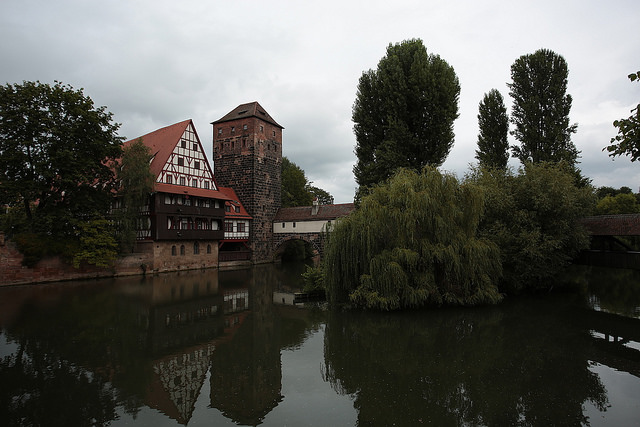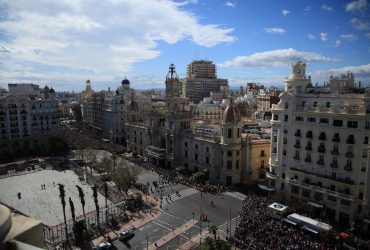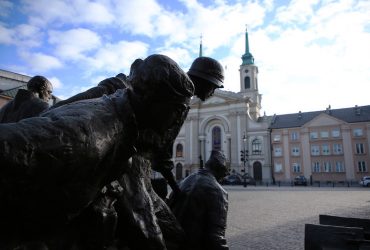I discovered that the medieval centre of Nuremberg, although the city was destroyed for 90% during the Second World War, has many stories and aspects to tell those who decide to spend a few days in the city. Thanks to a collaboration with the city tourism agency, I took part in a walking tour organised by the Nuremberg tourism board and which carry the participants to visit the centre of Nuremberg to discover many aspects of the history of this city.
Let’s start with some useful information about the tour:
– The guide speaks in English, but not too fast (you don’t need to be an English mother tongue person to understand).
– the tour (which I did) is held every day from April 14th, 2017 to January 6th, 2018;
– It starts at 13:00 from Hauptmarkt, in front of the tourist information office on the left side of the church (Hauptmarkt 18);
– The ticket costs 10 euros, children under 14 years do not pay (if they participate with an adult) and you can buy tickets in the tourist information offices (Königstraße 93 and Hauptmarkt 18)
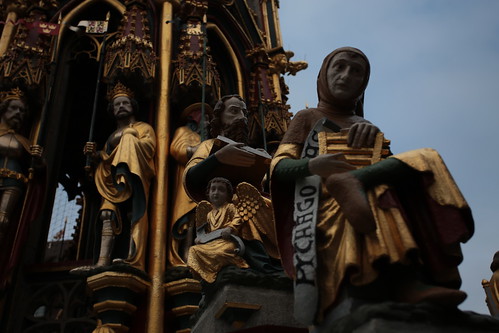 or from the guide itself just before the start of the tour. I will not report to you all the information and stories that the guide has shown us in about two hours of tour. I will try to write the most exciting: I hope, in this way, will make you want to take part in this round of discovery of the medieval Nuremberg. The tour starts from under the Fontana Bella (Schöner Brunnen), and the guide explains that the forty statues found there represent the “Vision of the world of the Holy Roman Empire” and include philosophers, writers, electors and apostles. There are some small “cannons” that when lowered pour the water of the fountain itself: it seems not to be drinkable, so I do not recommend using it to replenish your own bottle!
or from the guide itself just before the start of the tour. I will not report to you all the information and stories that the guide has shown us in about two hours of tour. I will try to write the most exciting: I hope, in this way, will make you want to take part in this round of discovery of the medieval Nuremberg. The tour starts from under the Fontana Bella (Schöner Brunnen), and the guide explains that the forty statues found there represent the “Vision of the world of the Holy Roman Empire” and include philosophers, writers, electors and apostles. There are some small “cannons” that when lowered pour the water of the fountain itself: it seems not to be drinkable, so I do not recommend using it to replenish your own bottle!
 The fountain is surrounded by a grate in which a gold ring is “embedded” (I will not tell you where: I challenge you to find it alone and let me know if you found it). It is said that one of the fountain builder’s apprentices is he fell in love with the daughter of the builder himself, who, however, did not consider him worthy of his daughter. The boy, therefore, decided to prove to be suitable for the daughter by forging this gold ring in which you can’t see or feel the joint point: it turns out to be a sort of “perfect ring” made simply perfect “by a simple apprentice”! It is said that If you make a wish while you’re spinning the ring three
The fountain is surrounded by a grate in which a gold ring is “embedded” (I will not tell you where: I challenge you to find it alone and let me know if you found it). It is said that one of the fountain builder’s apprentices is he fell in love with the daughter of the builder himself, who, however, did not consider him worthy of his daughter. The boy, therefore, decided to prove to be suitable for the daughter by forging this gold ring in which you can’t see or feel the joint point: it turns out to be a sort of “perfect ring” made simply perfect “by a simple apprentice”! It is said that If you make a wish while you’re spinning the ring three
 times, it makes the expressed desire come true. In front of the fountain, there is Frauenkirche, a church dedicated to the Madonna. The guide told us about the expulsion-eviction of the inhabitants of this area (I didn’t mark the year, mea culpa), for the construction of the square and the market: it seems we could almost look at this church as a means of “reconciliation” with the citizens. At this point in the story, the guide shows us a picture: taken at the end of the Second World War in Hauptmarkt there are American soldiers who “pose” the American flag (Nuremberg was a central and fundamental city for the National Socialist party). Placing that flag in the city centre on Hitler’s birthday, was a significant gesture (the night before that event it seems that the Americans also sent a happy birthday telegram to Hitler).
times, it makes the expressed desire come true. In front of the fountain, there is Frauenkirche, a church dedicated to the Madonna. The guide told us about the expulsion-eviction of the inhabitants of this area (I didn’t mark the year, mea culpa), for the construction of the square and the market: it seems we could almost look at this church as a means of “reconciliation” with the citizens. At this point in the story, the guide shows us a picture: taken at the end of the Second World War in Hauptmarkt there are American soldiers who “pose” the American flag (Nuremberg was a central and fundamental city for the National Socialist party). Placing that flag in the city centre on Hitler’s birthday, was a significant gesture (the night before that event it seems that the Americans also sent a happy birthday telegram to Hitler).
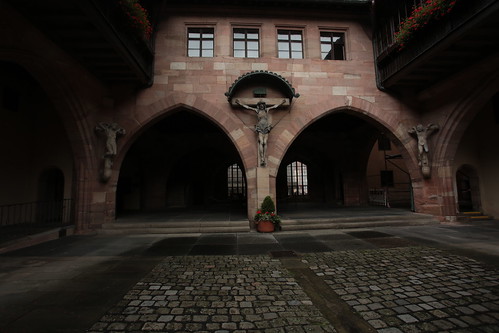 The next stop is the Heilig-Geist-Spital, or rather the house for the poor: before becoming a home that houses the poor, people who do have no one who can help them and who have difficulty keeping up, this building housed the first “house of mayor” in all of Germany! The change of destination of the building was possible (also) thanks to a massive donation. We stop in the inner courtyard of the building, undoubtedly noteworthy, with a focus on the history of Nuremberg.
The next stop is the Heilig-Geist-Spital, or rather the house for the poor: before becoming a home that houses the poor, people who do have no one who can help them and who have difficulty keeping up, this building housed the first “house of mayor” in all of Germany! The change of destination of the building was possible (also) thanks to a massive donation. We stop in the inner courtyard of the building, undoubtedly noteworthy, with a focus on the history of Nuremberg.
 In 1520 the city was the first German city to convert to the Lutheran-Protestant Christian religion and, for this reason, King Charles IV took away many of the privileges that Nuremberg had (compared to the rest of the country). This fact, the discovery of America and the Thirty Years’ war marked a substantial decline of Nuremberg (which is practically “in the middle of Europe”, take a look at the map to find out). In the Napoleonic era, it returns to shine and becomes the most significant industrial city in Germany! We leave the inner courtyard to go and have a look at the building from the Museumsbrücke, the “museum bridge”. This small bridge is a sort of “photographic point” where all tourists stop to take a picture or a selfie: in fact, the foreshortening is not bad! The ‘Bridge’ building that connects the islet with the river bank and which is seen well (only) from the bridge, is still part of the house for the poor.
In 1520 the city was the first German city to convert to the Lutheran-Protestant Christian religion and, for this reason, King Charles IV took away many of the privileges that Nuremberg had (compared to the rest of the country). This fact, the discovery of America and the Thirty Years’ war marked a substantial decline of Nuremberg (which is practically “in the middle of Europe”, take a look at the map to find out). In the Napoleonic era, it returns to shine and becomes the most significant industrial city in Germany! We leave the inner courtyard to go and have a look at the building from the Museumsbrücke, the “museum bridge”. This small bridge is a sort of “photographic point” where all tourists stop to take a picture or a selfie: in fact, the foreshortening is not bad! The ‘Bridge’ building that connects the islet with the river bank and which is seen well (only) from the bridge, is still part of the house for the poor.
 On the other side of the bridge you can see another slightly smaller bridge called “Fleischbrücke” (bridge of the meat): the guide explains us that, for its construction, the designers and builders were inspired by the Rialto bridge Venice. The tour continues along an iron bridge that takes us to the Farmer’s Island. From where we stop we can see a building that was intended for the poor: today it is a student house for the students of the University of Nuremberg. The building still has a medieval appearance and overlooks the city’s river. Always from the same point of the island, the guide points out a letter on the part of the ancient city walls: the men who could fight had a “letter assigned” to know where to go in case the city needed defence against attacks by enemies. The excellent organisation from this point of view allowed a guard almost perfect from overland: Nuremberg was never taken or destroyed with ground attacks, but only through airstrikes! Then we cross the Kettensteg bridge, the “chains bridge”, an all-iron bridge that resembles the “suspension bridges”. If you walk over it, you will feel a tremor due to the passage of people (once above, the guide makes us experience the swing of the bridge
On the other side of the bridge you can see another slightly smaller bridge called “Fleischbrücke” (bridge of the meat): the guide explains us that, for its construction, the designers and builders were inspired by the Rialto bridge Venice. The tour continues along an iron bridge that takes us to the Farmer’s Island. From where we stop we can see a building that was intended for the poor: today it is a student house for the students of the University of Nuremberg. The building still has a medieval appearance and overlooks the city’s river. Always from the same point of the island, the guide points out a letter on the part of the ancient city walls: the men who could fight had a “letter assigned” to know where to go in case the city needed defence against attacks by enemies. The excellent organisation from this point of view allowed a guard almost perfect from overland: Nuremberg was never taken or destroyed with ground attacks, but only through airstrikes! Then we cross the Kettensteg bridge, the “chains bridge”, an all-iron bridge that resembles the “suspension bridges”. If you walk over it, you will feel a tremor due to the passage of people (once above, the guide makes us experience the swing of the bridge
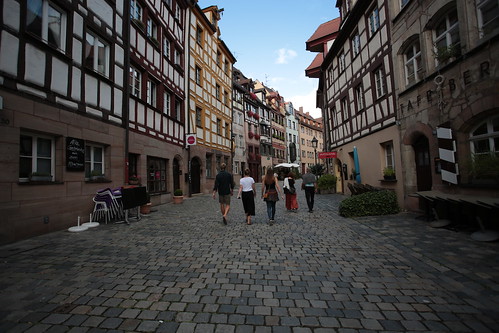 asking us jump on the catwalk!). Not far away is the road that struck me most in the historic centre of Nuremberg: the Weißgerbergasse, a pedestrian street and where the city’s artisans lived in ancient times. In ancient times the houses along the street were transformed with the construction of the ground floor in stone: this is because there was usually the kitchen and the fact that the buildings were built with materials that
asking us jump on the catwalk!). Not far away is the road that struck me most in the historic centre of Nuremberg: the Weißgerbergasse, a pedestrian street and where the city’s artisans lived in ancient times. In ancient times the houses along the street were transformed with the construction of the ground floor in stone: this is because there was usually the kitchen and the fact that the buildings were built with materials that
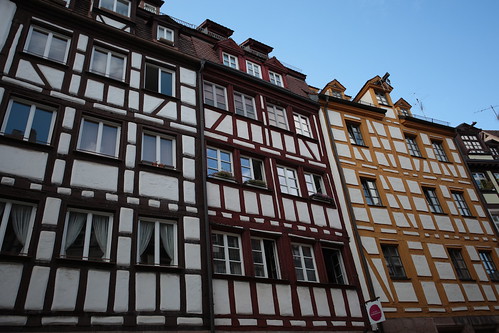 did not take fire like wood or straw. How It’s possible to distinguish the houses of the (more) rich from the homes of the poor? Well, the thing was, and it’s simple: the first could afford houses wholly made of stone! Alongside the small buildings, the particular paintings on the façades and the environment created by the facades, the vases and many small details that alone would perhaps mean almost nothing.
did not take fire like wood or straw. How It’s possible to distinguish the houses of the (more) rich from the homes of the poor? Well, the thing was, and it’s simple: the first could afford houses wholly made of stone! Alongside the small buildings, the particular paintings on the façades and the environment created by the facades, the vases and many small details that alone would perhaps mean almost nothing.
 At this moment, the tour starts to go uphill for the last part of the walk, and we stop in front of the Church of San Sebaldo. There is a particular aspect that immediately strikes in this church: If you look at it from the side you can see that at length it has two different heights! The front part, which is lower than the rest of the building, is from Roman times and the back part, the tallest, is from medieval times. This difference is because, during the Middle Ages, there were a lot of people to accommodate a massive number of people. San Sebaldo was one of the very first pilgrims to walk the path of Santiago; the guide also tells us that, in ancient times, many could not afford to leave home and work to get on pilgrimage and some figures were paid to make the pilgrimage “for others”. The tour, therefore, includes a stop in front of the statue of Albrecht Dürer, which is located in the centre of the small square that bears his name. The stop is speedy: the guide needs it just to explain that this is one of the first statues dedicated to an artist: previously sculptures were created only for kings, princes or saints.
At this moment, the tour starts to go uphill for the last part of the walk, and we stop in front of the Church of San Sebaldo. There is a particular aspect that immediately strikes in this church: If you look at it from the side you can see that at length it has two different heights! The front part, which is lower than the rest of the building, is from Roman times and the back part, the tallest, is from medieval times. This difference is because, during the Middle Ages, there were a lot of people to accommodate a massive number of people. San Sebaldo was one of the very first pilgrims to walk the path of Santiago; the guide also tells us that, in ancient times, many could not afford to leave home and work to get on pilgrimage and some figures were paid to make the pilgrimage “for others”. The tour, therefore, includes a stop in front of the statue of Albrecht Dürer, which is located in the centre of the small square that bears his name. The stop is speedy: the guide needs it just to explain that this is one of the first statues dedicated to an artist: previously sculptures were created only for kings, princes or saints.
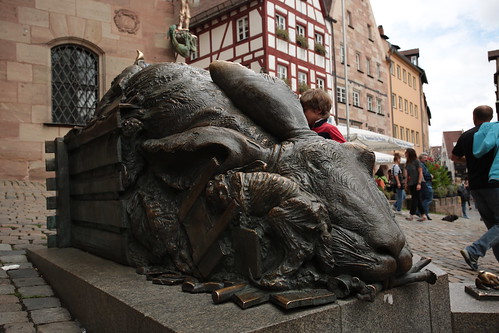 The last stop is Tiergärtnertor, the door of the walls in the shadow of the castle hill and front of the Albrecht Dürer house museum. Here is “Der Hase“, “the rabbit”, which represents a colossal rabbit while is breaking a wooden box and also crushes a man (you can see a foot on his right side). The statue is inspired by a work by Dürer and seems to want to represent the force of nature that manages to win over everything, including human beings.
The last stop is Tiergärtnertor, the door of the walls in the shadow of the castle hill and front of the Albrecht Dürer house museum. Here is “Der Hase“, “the rabbit”, which represents a colossal rabbit while is breaking a wooden box and also crushes a man (you can see a foot on his right side). The statue is inspired by a work by Dürer and seems to want to represent the force of nature that manages to win over everything, including human beings.
Nuremberg Walking tour
